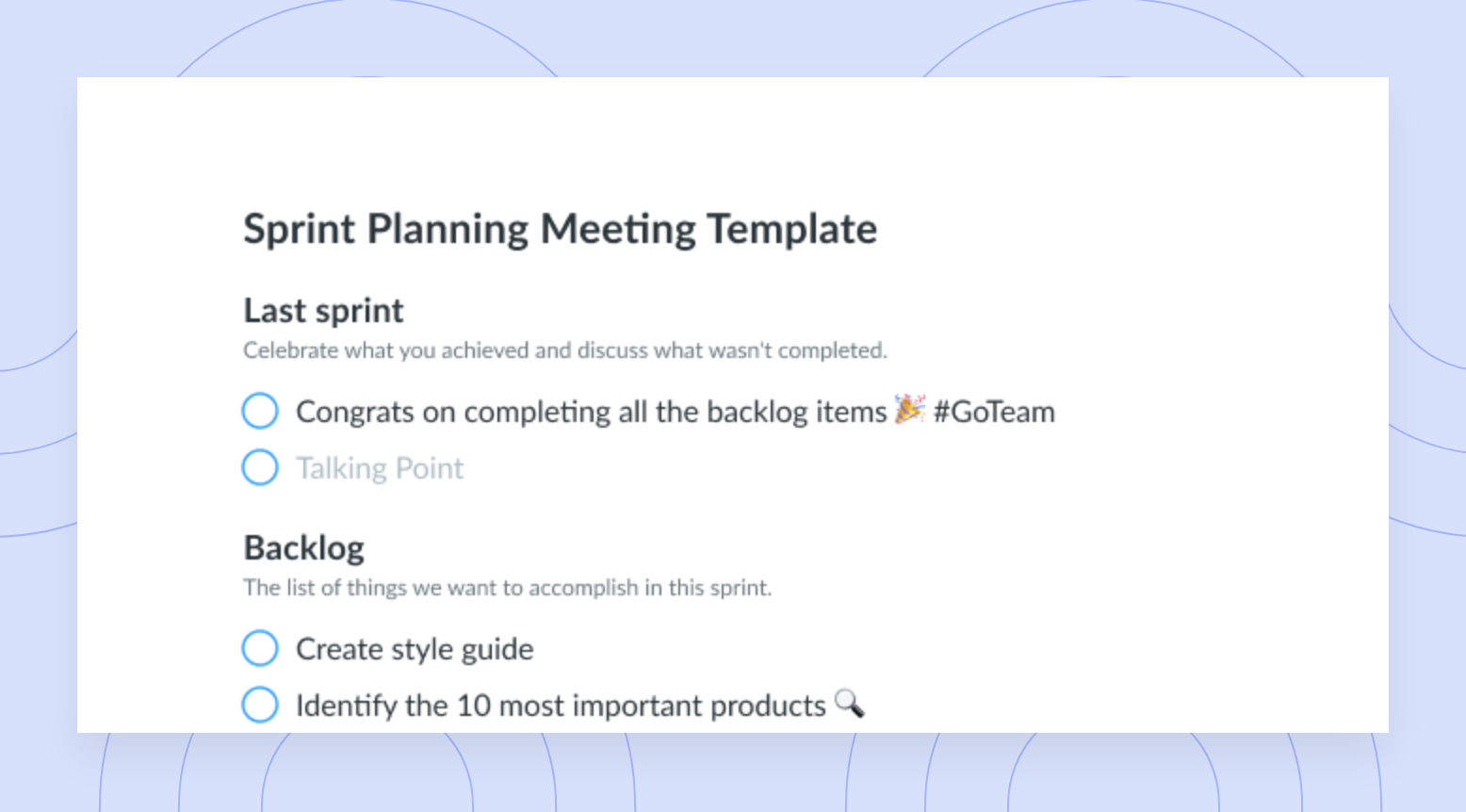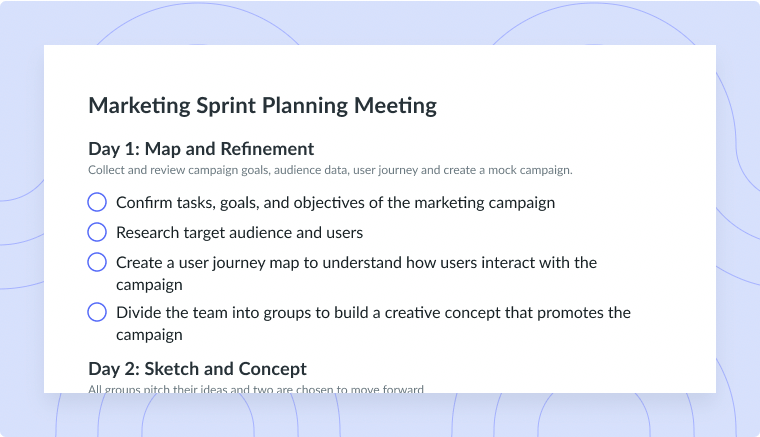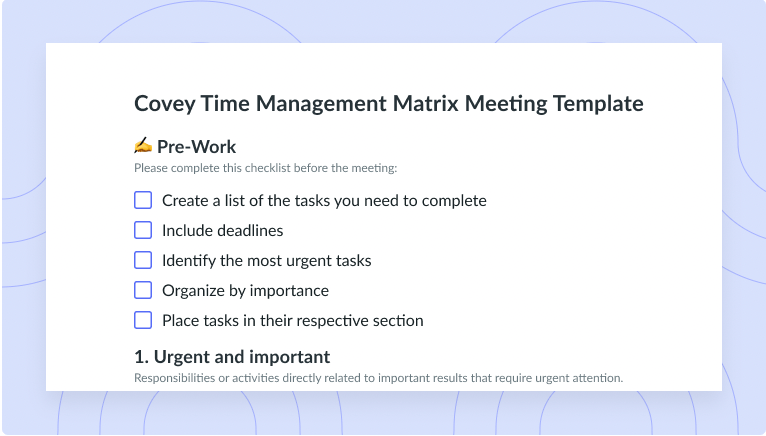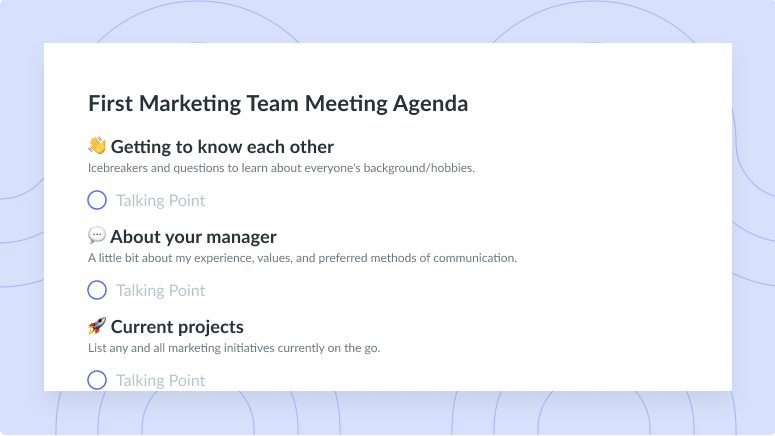13 Tips for Workload Management for You and Your Team
Managing your team’s workload can be a delicate process. Here are some tips on balancing your team's workload.
This might not come as a surprise to most managers, but it still bears saying: Stress can kill productivity. Think about it: When the pressure starts to build beyond control, isn’t all your work way harder to achieve? It happens to your team, too. Team members with crowded plates can feel stressed, unprepared, and like there’s simply not enough time to get everything done. This only increases opportunities for errors and missed deadlines. At the same time, giving them too few tasks can slow down the entire project.
Smart workload management can solve this problem. Though balancing your team’s workload can be challenging, you can have everyone meeting deadlines with the below tips.
- What is workload management?
- 13 tips for workload management
- Why is workload management important?
- Workload management tools
What is workload management?
Workload management is the process of efficiently delegating tasks to your team members based on their time and skills. Ideal work management results in team members handling only tasks they have the skills to complete and the time to handle. The goal is for everyone to feel satisfied with their accomplishments rather than overwhelmed by their task lists. Effective workload management can also help employees feel more engaged with their work, and that usually means higher-quality results.

Keep track of it all
Stay organized by having action items all in one place so you know where your team is with their workload. Try a tool like Fellow!
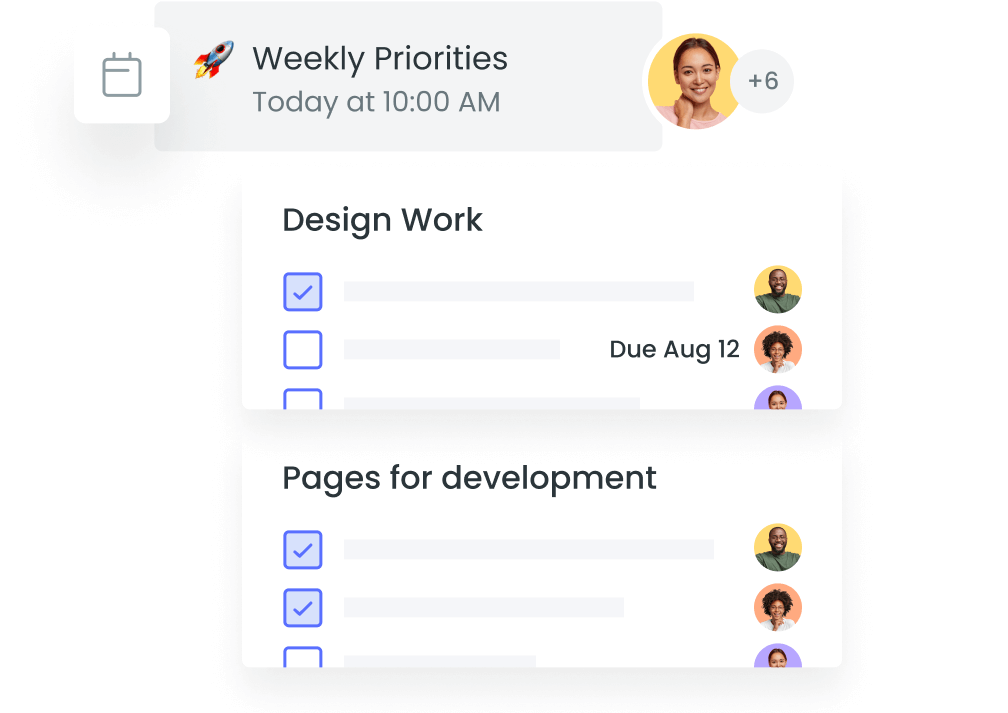
13 tips for workload management
While knowing how to manage a team’s workload is a valuable skill, learning it can be easier said than done. You might not have any formal training in optimally distributing work, and that gap can lead to inefficient task allocation. But then again, you don’t need to step into a classroom to manage your team’s workload. The below workload management tips can help you keep your team both productive and happy.
- Make room for planning
- Figure out your team’s workload and capacity
- Estimate tasks and deadlines
- Allocate tasks
- Set SMART goals
- Measure and monitor progress
- Avoid multitasking
- Hold standup meetings
- Share administrative tasks
- Block off time to catch up on emails
- Start with the hardest task
- Remember work/life balance
- Monitor schedules, milestones, and projects
1 Make room for planning
Chances are your team will have the easiest time completing projects with well-defined goals and established processes. Sure, improvisation and last-minute changes have their place, especially when your team runs into unexpected obstacles. But on-the-fly thinking at all times can confuse or frustrate team members working hard to meet deadlines.
Having a solid plan for the project – and specific tasks to go with it – gives your team a clear path from start to finish. The result is better workflow management – you’re telling everyone how to get from point A to point B. Your plan will also help you and your team track objectives and progress more accurately and estimate when you’ll reach certain project milestones.
2 Figure out your team’s workload and capacity
When you’re working on a group project, you need a really strong sense of your team’s skills and capacity. After all, you’ll rely on your team members’ skills and time pretty heavily. So before you start assigning tasks, make sure you know the type and amount of work the project requires. Your team can quickly end up overwhelmed if you determine project workloads and delegate tasks by team member skill without considering time.
Instead, you should always break a project down into the tasks needed to complete it. From there, you should break more complex tasks into more manageable chunks. Then, try organizing each of those chunks by importance and deadline. Finally, you should assign each task to certain team members based on their ability to complete them. That means both their skills and their schedules.
3 Estimate tasks and deadlines
Analyzing a project and determining how much work time each task will take can help you set realistic deadlines. You should do more than ask when an employee can finish a task – speed can be difficult to gauge during a task. You should also give employees the tools to automatically track their time and conduct a time audit.
Sure, if you’ve worked with your team for long enough, you’ll have a better sense of how much work they can handle. But numbers are always more concrete than, say, “Oh, I’m confident my team can handle this new task in a few hours.” Properly evaluating your team’s workflows can help you better distribute tasks and time among your team and set realistic deadlines accordingly.
4 Allocate tasks
As you work through a project, it might seem more efficient to give the highest-performing team members a greater share of the work. In reality, putting so much work on the backs of so few often causes more problems than it solves. You could wear down your best employees and underutilize your other team members. It’s better to get all hands on deck during a project to keep every team member’s workload manageable.
Namely, you should ensure that each team member must complete a number of tasks realistic for their skills and schedule. Resource allocation helps here too, as distributing necessary materials appropriately helps ensure a smooth workflow for your team.
5 Set SMART goals
In business, SMART goals are Specific, Measurable, Attainable, Relevant, and Time-bound. These goals are concrete, practical, and inherently full of helpful context.
A specific goal satisfies a particular need. Measurable goals can be quantified and analyzed. Attainable goals are realistic – as in, you can feasibly take the steps needed to achieve them. Relevant goals clearly further the objectives of your company. Time-bound goals have deadlines you can reach without reaching burnout.
6 Measure and monitor progress
Workload management doesn’t stop after you assign team tasks. Even if you’re confident your team can handle the work, you never know what roadblocks will unexpectedly emerge. You should keep an eye on your team’s progress with an hours tracker or a project management tool, so you can more easily make changes in real-time when these obstacles arise.
For example, let’s say you’re having a one-on-one meeting with the team member responsible for collecting survey data from 400 customers. During a meeting a week from the project deadline, the team member tells you they still need data from 200 other customers. That news might not be the best, but it is a concrete measurement of progress. It’s a jumping-off point for making whatever adjustments are necessary to get that additional customer data.
7 Avoid multitasking
That itch to do more work in less time is understandable, and you shouldn’t shove it away. But you also shouldn’t address it in the wrong way. Multitasking your way to productivity is just not the way to go about it.
Studies have found that the human brain simply isn’t wired to effectively handle more than one task at once. That’s why it’s always better to give your undivided attention to one responsibility. You’ll handle that task at full capacity and better devise ways to overcome unforeseen obstacles. Conversely, multitasking leads to constant gear-switching that requires the brain to constantly adjust. Those adjustments are how you lose time and quality.
8 Hold standup meetings
When was the last time you worked through a project without holding any team meetings? We’ll wager a guess: Never. Team meetings are an incredibly valuable way to keep all your team members on the same path as everyone works toward the same goal. But if you’re not the most confident meeting host, you could wind up running meetings that are too long. You can hold standup meetings to avoid this issue.
As their name suggests, standup meetings happen standing up rather than sitting. That odd structure can add some urgency to your meetings, so your team is more inclined to quickly address what needs to be done and go on their way. That’s why most standup meetings give everyone present at most a minute to talk and share updates. And then, you all simply walk out and get back to work.
9 Share administrative tasks
Your organization’s everyday operations – things like maintaining databases and calendars – are the gears that move the machine. They’re also not always things you’ll have time for amid a big task or project. At the same time, you can’t ignore these tasks. But also at the same time, you just can’t let these tasks distract you from more critical responsibilities. What can, or should, you do?
Introducing a workload management system is a start. These systems can help you organize your daily tasks into realistic to-do lists that leave time for the administrative stuff. You can go even further and add automation tools into the mix that literally do certain administrative tasks for you. That way, you free up your work hours and almost entirely remove human error from minor but essential work.
10 Block off time to catch up on emails
Having a clear schedule to complete your assignments won’t stop people from calling or emailing you. Not that these inquiries are typically difficult to resolve, but responding to them as they arrive can mean you’re constantly interrupting your most important work. And ignoring calls and emails certainly isn’t gonna help you.
Instead, you and your team should schedule time blocks where you only answer emails or return missed calls. You can also set blocks in which you’re available for calls and tell people they can’t reach you at other times. This way, you keep in touch with everyone who matters to your work and take a small break from your biggest tasks. What a productive way to refresh your mind!
11 Start with the hardest task
In other words, “eat the frog.” To be clear: We don’t recommend eating a literal frog. Instead, “eating the frog” is a phrase you’ll hear in workload and time management that’ll help you handle the most complex tasks first.
Many people save their most challenging tasks until last because they simply dread those tasks. You might accidentally reinforce this mindset as you assign tasks to your teams – do the easy stuff first, hard stuff later. “Eating the frog” encourages the opposite mindset. Basically, the least desirable tasks are frogs, and when you eat them, everything else thereafter will taste (okay, feel) much better. The result is a smoother and more balanced workflow.
12 Remember work/life balance
There’s more to your team members’ lives than the workplace, and you should keep that in mind while assigning work. Don’t be that manager who asks for employees to work into the wee hours or on the weekends. Instead, cater to each employee’s schedule, which will likely differ based on their priorities.
Similarly, a key workload management tip is only to give your team members work they can handle. Tasks someone can handle lie both within their skillset and schedule. Adhering to this principle is akin to heeding “quality over quantity.” It’s often better to do a slightly smaller amount of great work than an overwhelming amount of clearly flawed work.
13 Monitor schedules, milestones, and projects
This workload management tip somewhat speaks for itself, but knowing the milestones your team must hit can lead to more accurate project timelines. Plus, keeping your team’s schedules and abilities front-of-mind can make it easier to respond to unforeseen complications. The more of a beat you keep on all parts of the project, the more easily you can make any necessary adjustments.
Why is workload management important?
Effective workload management techniques help keep your team members motivated and on deadline, all while leading to high-quality work. Plus, great workload management fends off burnout and its accompanying severe dips in productivity and work quality. Spread burnout among an entire workforce, and you’re basically self-sabotaging. Effective workload management is the solution: It yields lower turnover rates, more employee engagement, and a team that produces quality and quantity.
Workload management tools
Workload planning tips are a great start, but workload management software can truly be the skeleton key that unlocks all your team members’ highest potential. These tools can help you assign tasks, share resources, and keep track of everything with pretty much no hassle.
Workload management tools gather all your team’s tasks and progress in one easily accessible place. From your workload management platform’s dashboard, you can observe how each team member handles their work, and you can reassign tasks as needed. You can also collaboratively set SMART goals and objectives that guide your team to a meaningful final destination.
The meeting tool Fellow, for example, includes several objectives and key results (OKR) features that help you plan several aspects of your projects. An OKR is a broad, long-term goal that you and your team will work toward throughout a project. With Fellow, you can break these objectives into more manageable tasks and track all the action. You’ll see progress toward each track as a percentage that changes color as your team gets closer to the main goal.
A happy employee is a successful employee
Effective team workload management can be challenging even for experienced managers, but it’s rarely impossible. To start, just judge how much work each team member can handle based on their abilities and schedules. Then, keep checking in so you avoid burnout while still producing better work in less time. You’ll know you’re doing it right if you can consistently adjust workloads as needed with minimal confusion.
Sure, workload management can get complicated, but the right apps can help you more effectively assign tasks and share resources. The Fellow app, for example, features several tools for ensuring your meetings result in clear tasks and deadlines. Between our OKR and meeting action item features, you’ll have everything you need to establish your goals, who’s reaching which ones, and by when they’re doing so. Your team will stay on track like never before.









